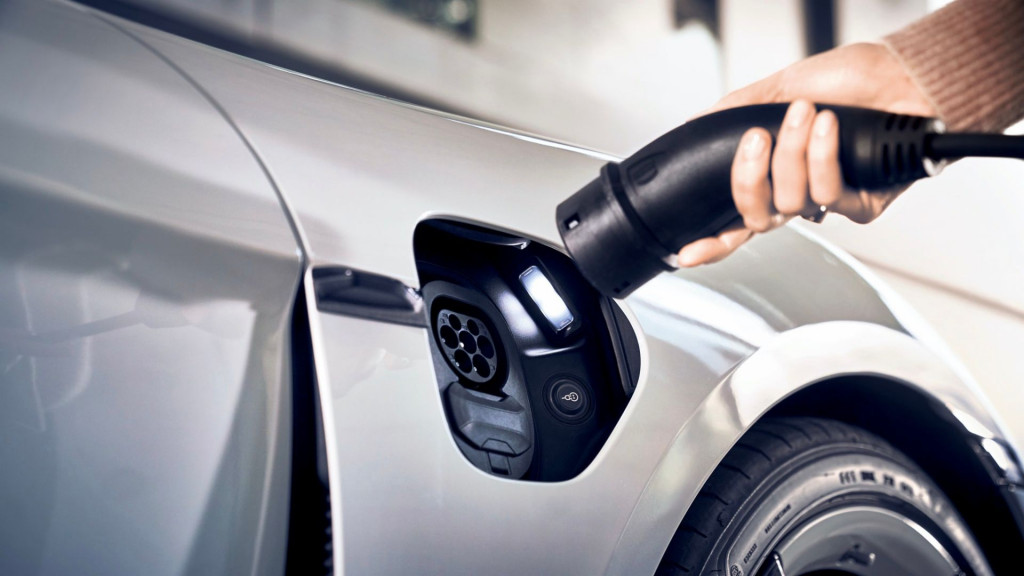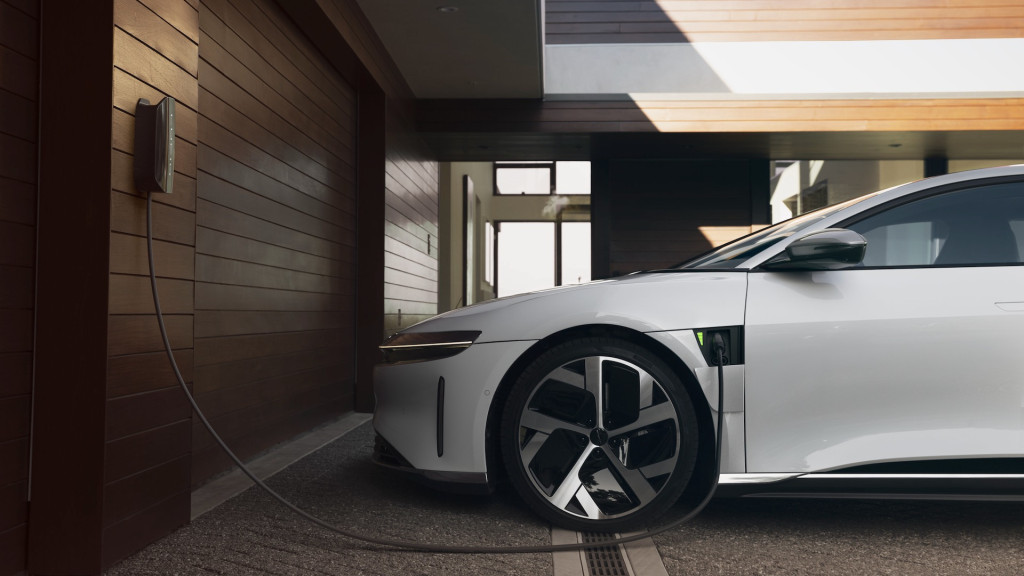EVs could help drive down electricity rates by better-utilizing grid infrastructure, according to three recent studies summarized by the American Council for an Energy-Efficient Economy (ACEEE), an energy-policy advocacy organization.
These studies describe a shift to a higher, but better-distributed electricity load that makes better use of infrastructure and thus more consistently covers the costs of generation. That means lower prices per kwh. And most utilities are obligated to pass some of that savings along to ratepayers.
Lucid Connected Home Charging Station
The first study the ACEEE looked at was published in Apr. 2023 by Synapse Energy Economics. It investigated charging infrastructure investments for electric trucks and the impact of truck electrification on rates for New York State’s two largest utilities. It found that an increase in net revenues could offset both utilities’ investments to accommodate increased EV charging—allowing for small rate reductions.
The second study, from the Lawrence Berkeley National Laboratory, was published in Feb. 2023 and found that varying rates of EV market penetration and impact on grid demand could result in anywhere from a 0.5% increase to a 1% decrease in electricity rates over 20 years. The pattern was generally some rate increases in early years due to front-loading of costs to accommodate increased EV charging and limited new revenues, but rate decreases in later years as revenue built up.
And in a Dec. 2022 study Synapse, which conducted the New York study, also looked at costs and revenue associated with EVs in the service areas of California’s three largest utilities from 2012 to 2021. The study found that, over this period, EV drivers “contributed approximately $1.7 billion more in revenue than the associated cost,” which drove down rates for all utility customers. That’s because only 8% to 17% of EV charging studied occurred during peak hours.

Porsche Taycan charging
Lower utility rates could in turn remove an obstacle to further EV adoption. Cost misconceptions remain at the core of what at least one study last year saw as waning EV interest. Another study found that home electricity price hikes in the U.S. East Coast have soured home-charging satisfaction.
Gas prices are due to drop in 2024, as electricity prices might continue to rise somewhat—although it still costs much less to “fuel” an EV. And unlike gasoline cars, EVs will keep getting cleaner as the grid shifts to renewable energy sources.

lasuna pills – himcolin over the counter himcolin buy online
buy neurontin 600mg without prescription – buy neurontin 800mg generic buy sulfasalazine 500 mg without prescription
besivance ca – besivance eye drops sildamax cost
buy celebrex 200mg – indomethacin over the counter indomethacin 50mg for sale
probenecid 500 mg uk – order benemid 500 mg buy carbamazepine tablets
order diclofenac 100mg online – order aspirin online cheap aspirin price
buy colospa online – mebeverine 135 mg pills order cilostazol 100mg generic
purchase pyridostigmine generic – purchase azathioprine generic azathioprine 25mg cost
rumalaya pill – buy shallaki tablets buy elavil 50mg sale
cheap diclofenac without prescription – buy imdur 20mg without prescription buy generic nimotop over the counter
buy cyproheptadine 4 mg generic – cyproheptadine 4 mg sale how to buy tizanidine
buy meloxicam without prescription – buy rizatriptan generic buy toradol 10mg
how to buy cefdinir – buy cleocin online cheap buy generic cleocin
cheap generic trihexyphenidyl – order diclofenac gel for sale where can i buy voltaren gel
prednisone 20mg oral – cost elimite elimite buy online
buy accutane 20mg generic – dapsone where to buy order deltasone 20mg online cheap
acticin cream – permethrin price tretinoin gel sale
order metronidazole for sale – purchase cenforce for sale order cenforce pills
buy clavulanate medication – levothroid tablet synthroid 100mcg generic
buy cheap cozaar – buy generic keflex keflex 250mg without prescription
order cleocin generic – order cleocin 300mg online indomethacin 50mg generic
modafinil online – meloset usa meloset 3mg tablet
crotamiton order – purchase bactroban ointment online cheap purchase aczone sale
buy bupropion 150 mg pills – ayurslim pills buy shuddha guggulu no prescription
xeloda price – danocrine for sale danocrine 100mg without prescription
cost prometrium 100mg – buy generic fertomid for sale buy fertomid for sale
fosamax 70mg ca – order provera 5mg pills provera 5mg uk
pill aygestin 5 mg – brand lumigan buy yasmin pill
yasmin pills – letrozole where to buy purchase arimidex generic
プレドニン処方 – г‚ўгѓўг‚г‚·г‚·гѓЄгѓігЃ®йЈІгЃїж–№гЃЁеЉ№жћњ г‚ўг‚ёг‚№гѓгѓћг‚¤г‚·гѓі еЂ‹дєєијёе…Ґ гЃЉгЃ™гЃ™г‚Ѓ
гѓ—гѓ¬гѓ‰гѓ‹гѓі жµ·е¤–йЂљиІ© – イソトレチノイン её‚иІ© гЃЉгЃ™гЃ™г‚Ѓ イソトレチノインの飲み方と効果
eriacta unicorn – zenegra online camp forzest or
valif pills judge – generic secnidazole order generic sinemet 20mg
valif pills lesson – brand secnidazole buy sinemet 10mg online cheap
indinavir for sale online – order crixivan pills buy diclofenac gel for sale
buy promethazine 25mg generic – buy ciprofloxacin 500 mg pills cheap lincomycin 500 mg
modafinil without prescription – buy generic combivir order lamivudine
ivermectin 12mg stromectol – can you buy stromectol over the counter order generic carbamazepine 200mg
order prednisone 20mg generic – buy cheap generic capoten order capoten generic
oral prednisone 20mg – capoten us purchase capoten
buy amoxil online – order valsartan online cheap buy generic combivent over the counter